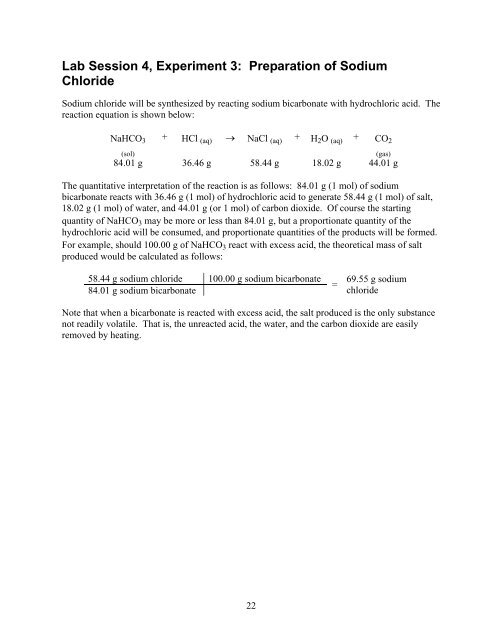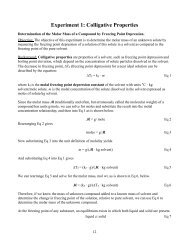Lab Session 4, Experiment 3: Preparation of Sodium Chloride
Lab Session 4, Experiment 3: Preparation of Sodium Chloride
Lab Session 4, Experiment 3: Preparation of Sodium Chloride
You also want an ePaper? Increase the reach of your titles
YUMPU automatically turns print PDFs into web optimized ePapers that Google loves.
<strong>Lab</strong> <strong>Session</strong> 4, <strong>Experiment</strong> 3: <strong>Preparation</strong> <strong>of</strong> <strong>Sodium</strong><br />
<strong>Chloride</strong><br />
<strong>Sodium</strong> chloride will be synthesized by reacting sodium bicarbonate with hydrochloric acid. The<br />
reaction equation is shown below:<br />
NaHCO3<br />
(sol)<br />
+ HCl (aq) → NaCl (aq) + H2O (aq) + CO2<br />
22<br />
(gas)<br />
84.01 g 36.46 g 58.44 g 18.02 g 44.01 g<br />
The quantitative interpretation <strong>of</strong> the reaction is as follows: 84.01 g (1 mol) <strong>of</strong> sodium<br />
bicarbonate reacts with 36.46 g (1 mol) <strong>of</strong> hydrochloric acid to generate 58.44 g (1 mol) <strong>of</strong> salt,<br />
18.02 g (1 mol) <strong>of</strong> water, and 44.01 g (or 1 mol) <strong>of</strong> carbon dioxide. Of course the starting<br />
quantity <strong>of</strong> NaHCO3 may be more or less than 84.01 g, but a proportionate quantity <strong>of</strong> the<br />
hydrochloric acid will be consumed, and proportionate quantities <strong>of</strong> the products will be formed.<br />
For example, should 100.00 g <strong>of</strong> NaHCO3 react with excess acid, the theoretical mass <strong>of</strong> salt<br />
produced would be calculated as follows:<br />
58.44 g sodium chloride 100.00 g sodium bicarbonate<br />
84.01 g sodium bicarbonate<br />
= 69.55 g sodium<br />
chloride<br />
Note that when a bicarbonate is reacted with excess acid, the salt produced is the only substance<br />
not readily volatile. That is, the unreacted acid, the water, and the carbon dioxide are easily<br />
removed by heating.
3A <strong>Experiment</strong><br />
Chemicals needed: sodium bicarbonate, concentrated hydrochloric acid.<br />
1. Accurately weigh an empty, dry evaporating dish, and record its mass in blanks (b) and (e) in<br />
the table below.<br />
2. Add to the dish about 5 g <strong>of</strong> NaHCO3 and weigh again. Record the mass in blank (a) in the<br />
table below.<br />
3. Add 5 to 6 mL <strong>of</strong> distilled water to the dish to wet the bicarbonate. Cover the dish with a<br />
watch glass.<br />
4. Move the watch glass aside slightly and add, in small portions, about 6 mL <strong>of</strong> concentrated<br />
hydrochloric acid from a 10 mL graduated cylinder. These small portions <strong>of</strong> acid should be<br />
added so that the acid runs down the inside wall <strong>of</strong> the evaporating dish. After the addition<br />
<strong>of</strong> 6 mL <strong>of</strong> acid, continue adding acid only as long as CO2 (gas) continues to be evolved.<br />
5. Remove the watch glass and evaporate to dryness over a water bath (the evaporating dish is<br />
placed on top <strong>of</strong> a beaker containing boiling water).<br />
6. Next, heat the dish on wire gauze with the burner for about 3 minutes. Allow the dish to cool<br />
and weigh accurately. Again, heat the dish, cool, and weigh. Continue heating and weighing<br />
until the dish reaches constant mass. Record this constant mass in blank (d) in the table<br />
below.<br />
(a) Mass <strong>of</strong> dish and NaHCO3<br />
g<br />
(b) Mass <strong>of</strong> empty dish g<br />
(c) Mass <strong>of</strong> NaHCO3 [(a)–(b)]<br />
g<br />
(d) Mass <strong>of</strong> dish and residue g<br />
(e) Mass <strong>of</strong> empty dish (b) g<br />
(f) Mass <strong>of</strong> NaCl residue [(d)–(e)] g<br />
7. In the reaction studied, what reactant was present in limiting quantity?<br />
3B Calculations<br />
1. Calculate the theoretical yield <strong>of</strong> NaCl.<br />
58.44 g NaCl _________ g NaHCO3<br />
84.01 g NaHCO3<br />
2. Calculate the percentage yield <strong>of</strong> NaCl.<br />
Actual yield × 100 ( )<br />
=<br />
Theoretical yield ( )<br />
23<br />
= ___________________g NaCl<br />
× 100 = ___________________%
3C Exercises<br />
In the following problems, show calculations:<br />
3. What theoretical mass <strong>of</strong> NaCl would result from reacting 60.00 g <strong>of</strong> NaHCO3 with excess<br />
HCl (aqueous)?<br />
58.44 g NaCl 60.00 g NaHCO3<br />
84.01 g NaHCO3<br />
= ___________________g NaCl<br />
4. What theoretical mass <strong>of</strong> NaCl would result from reacting 3.00 moles <strong>of</strong> NaHCO3 with<br />
excess HCl (aqueous)?<br />
3.00 mol NaHCO3 1 mol NaCl 58.44 g NaCl<br />
1 mol NaHCO3 1 mol NaCl<br />
5. What mass <strong>of</strong> CO2 would be generated along with 35.00 g <strong>of</strong> NaCl?<br />
35.00 g NaCl 44.01 g CO2<br />
58.44 g NaCl<br />
= ___________________g CO2<br />
24<br />
= ________________g NaCl
Report Form 3: <strong>Preparation</strong> <strong>of</strong><br />
<strong>Sodium</strong> <strong>Chloride</strong><br />
3A <strong>Experiment</strong><br />
25<br />
Name_________________________________<br />
Partner___________________Section #_____<br />
(a) Mass <strong>of</strong> dish and NaHCO3<br />
g<br />
(b) Mass <strong>of</strong> empty dish g<br />
(c) Mass <strong>of</strong> NaHCO3 [(a)–(b)]<br />
g<br />
(d) Mass <strong>of</strong> dish and residue g<br />
(e) Mass <strong>of</strong> empty dish (b) g<br />
(f) Mass <strong>of</strong> NaCl residue [(d)–(e)] g<br />
In the reaction studied, what reactant was present in limiting quantity?<br />
3B Calculations<br />
1. Theoretical yield <strong>of</strong> NaCl.<br />
2. Percentage yield <strong>of</strong> NaCl.<br />
3C Exercises<br />
3. What theoretical mass <strong>of</strong> NaCl would result from reacting 60.00 g <strong>of</strong> NaHCO3 with excess<br />
HCl (aqueous)?<br />
4. What theoretical mass <strong>of</strong> NaCl would result from reacting 3.00 mol <strong>of</strong> NaHCO3 with excess<br />
HCl (aqueous)?<br />
5. What mass <strong>of</strong> CO2 would be generated along with 35.00 g <strong>of</strong> NaCl?




